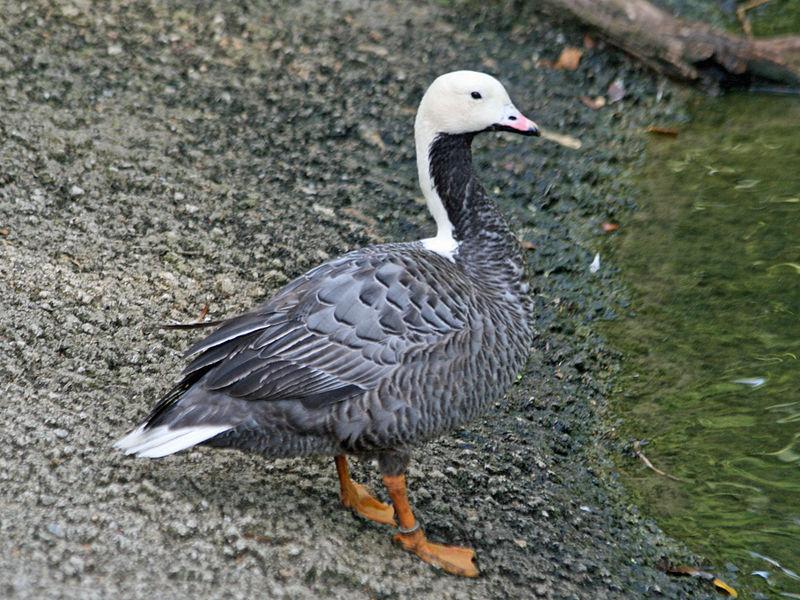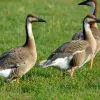
Emperor Goose (Anser canagica)
Species name
- Dutch name:
- Keizergans
- English name:
- Emperor Goose
- German name:
- Kaisergans
- French name:
- Oie empereur
- Scientific name:
- Anser canagica
Scientific classification
- Order:
- Anseriformes
- Family:
- Anatidae
- Onderfamilie:
- Anserinae
- Genus:
- Anser
Description
- Description:
Male:
The male is a small, stocky goose that has dark bluish-grey plumage with black barring on the upperparts. The legs and feet of the emperor goose are yellow-orange in color and the bill is pink. The head and hindneck are striking white, but are often stained an orange-red colour from feeding in tidal ponds where iron oxide is present in sufficient concentration.Female:
Identical to male but slightly smaller best when compared in pairs .Juvenile:
Emperor geese have a slightly duller appearance than the adults, with brown barring on the upperparts, grey mottling on the head and foreneck, a black bill and olive-brown legs
Standard Measurements
- Body Length (cm):
- The male (drake) of the Emperor Goose measures approximately 66-71 centimeters. The female measures approximately 65-70 centimeters.
- Body Weight (grams):
- The male will weight about 2760-3130 gram. The female will weight about 2585-3040 gram.
The weight is notoriously variable and can only be used as indication!
- Note:
Emperor geese are winter - hardy and easy to manage. A large area of grazing and lake of clear water preferred. They defend their nesting territory, therefore should be maintained in large area and a separate pen may be preferred for breeding. Good grazing will provide most of their food, with Lundi Regular floating Pellets.
These geese are easily bred in captivity. They nest in short grass with islands favoured for nesting, and they may also use ground-level nest boxes. Egg laying may begin end of April til June. Goslings are best pest parent-incubated and parent-reared. Goslings are fast growing and easy to rear, but need shelter protection from excessive heat and strong sunlight.
Nest placement and structure
On the ground, a shallow depression, lining of grass, feathers and down.- Breeding:
- The female Emperor Goose usually lays from 4-6 creamy white eggs and incubates them for 24-27 days.
- Artificial incubating:
The ideal relative humidity for incubating most waterfowl eggs is 55% (ground nesters) and 40% (cavity nesters). The temperature is usually 37.4°C. Set ventilation as recommended by the incubator manufacturer. Eggs must be turned, either automatically or by hand, a minimum of 4 times a day. As the duckling develops there is a loss of water from the egg and the air sac gets bigger. In normal development of an egg with a 24-27 days incubation, the air sac occupies about a third of it three days earlier. Cleanliness is vital and ideally eggs should be moved to a separate hatcher at this point, where the humidity should be increased to 65% and even higher once they have pipped internally.
- Bird banding:
- Recommended closed leg band ring size for the Emperor Goose is 16 mm.The leg band ring can only be applied on a young goose at around 12-14 days old.
- It doesn't matter what leg that you band, but it's good to have a consistent system. Suggested: Left leg = Female, Right leg = Male
- Maintenance food:
-





Lundi Regular with a protein content of 20%, valuable Spirulina and high-quality by-products is optimally balanced in its composition maintenance food for water ornamental fowl of all kinds. Especially green teal and Whistling ducks that are not dependent on a very high protein content, are well supplied.
Lundi Regular contains all the minerals and vitamins in full form that are important for the animals. Therefore also suitable as breeding food.



